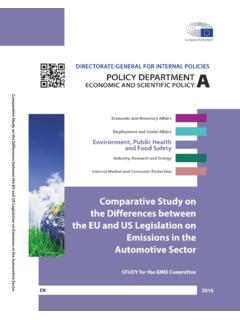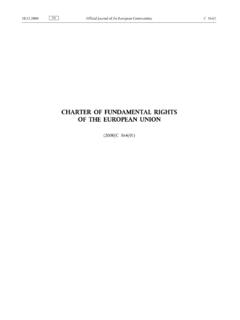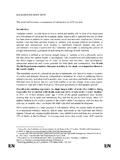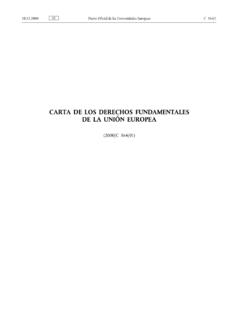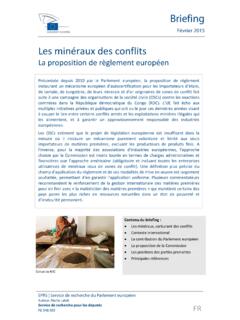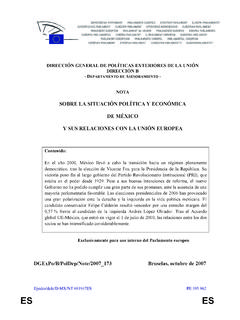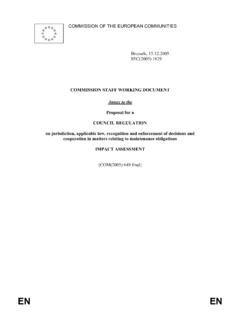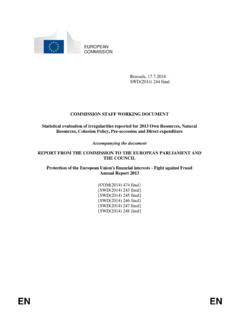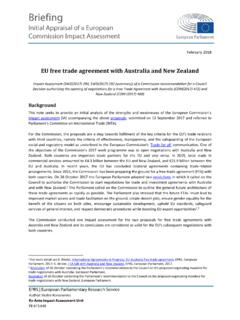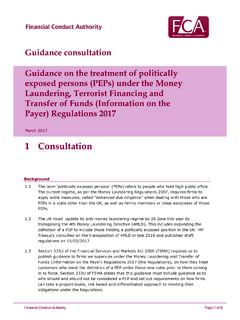Transcription of Understanding money laundering through real estate ...
1 BRIEFING EPRS | European Parliamentary Research Service Author: C cile Remeur Members' Research Service PE February 2019 EN Understanding money laundering through real estate transactions SUMMARY money laundering through real estate transactions integrates black funds into the legal economy while providing a safe investment. It allows criminals to enjoy assets and derived funds having camouflaged the origin of the money used for payment. A number of techniques are used, namely cash or opaque financing schemes, overvalued or undervalued prices, and non-transparent companies and trusts or third parties that act as legal owners.
2 Among the possible indicators are geographical features (such as the distance between the property and the buyer and their actual geographical centre of interest). In order to assess the existence of a money - laundering risk, concrete assessments of transactions and a customer's situation provide indications that help raise red flags and trigger reporting obligations. The anti- money - laundering recommendations set out by the international Financial Action Task Force (FAFT) are implemented in the European Union (EU) by means of coordinated provisions (chiefly the Anti- money - laundering Directive).
3 Customer due diligence and reporting of suspicious transactions are tools to address money laundering . Real estate transactions involve both non-financial and financial sector parties operating under different legal requirements. Yet, reporting of suspicious transactions in real estate is limited, leaving ample room for improvement. Improvement is all the more necessary inasmuch as money laundering in general, and in the real estate sector in particular, has a major socio-economic impact, the magnitude of which is difficult to quantify.
4 Awareness is however growing as a result not least of high profile examples of money laundering through real estate in a number of EU cities. In this Briefing Real estate : a haven for money launderers? Addressing the misuse of real estate for money laundering Tackling the problem: a work in progress Real estate money - laundering impact EPRS | European Parliamentary Research Service 2 Real estate : a haven for money launderers? Abuse of the real estate sector (property in the form of land or buildings) has long been described as one of the oldest known ways to launder ill -gotten gains.
5 Real estate is as attractive to criminals as it is to any investor (prices being generally stable and likely to appreciate over time) and is also functional (the property can be used as a second home or rented out, generating income). Real estate also provides a veneer of respectability, legitimacy and normality. This applies to both residential and commercial properties as part of a reliable and profitable investment strategy. Real estate transactions can involve large sums and are subject to more limited scrutiny with regard to money - laundering risks than financial sector transactions, as non-financial sector rules are much more Some illustrative snapshots This is a worldwide phenomenon,2 with plentiful examples from Canada, the United States, Australia and New Zealand to the European Union, Africa, Asia and Middle The transactions used for money laundering mainly concern houses and buildings.
6 But any form of immovable property can be used to this end, for instance vineyards. Some textbook cases, such as those for instance in Vancouver4 or London, highlight striking features such as: discrepancy between the usual income and wealth of the owner and the property: in some cases, the most expensive properties in the city are owned by individuals with no income or wealth that would allow them to purchase such a property; an anonymous owner, as a result of recourse either to a third party or to companies, trusts or similar arrangements; a property's underestimated or overvalued price.
7 The indication by a country that there is a risk of money laundering by its citizens in another Real estate in the money laundering cycle money laundering is the process used to camouflage the illegal origin of funds generated by illicit or criminal activities. By successfully laundering the proceeds of criminal activities, the illicit gains can be enjoyed without fear of their being confiscated. In real estate , money laundering involves using such funds to pay for the transaction (predicate offence of money laundering ).
8 Real estate plays a role (mainly) in the third and final stage of the money - laundering cycle, after the placement and the layering phases. Placement consists of moving funds directly associated with a crime and introducing them into the financial system ( breaking up large amounts into small deposits or purchasing financial instruments such as money orders). Layering is then designed to hide the trail and hinder pursuit by distancing the illegal proceeds from the source of the funds, using layers of financial transactions. Purchasing real property is one way to integrate black money into the legal economy, while also returning the illegally derived proceeds to the criminals concerned.
9 In addition, when sold or rented, real property provides what appears to be a legitimate source of income. Addressing the misuse of real estate for money laundering Identifying the misuse of real estate to launder money Reports based on surveys provide for a typology of the basic techniques used for laundering money through the real estate sector. The Organisation for Economic Co-operation and Development (OECD) published two in two consecutive years: the 2007 FATF report ' money laundering and Understanding money laundering through real estate transactions 3 terrorist financing through the real estate sector' and the 2008 OECD report 'Real estate sector: Tax fraud and money laundering vulnerabilities'.
10 6 Examples of real estate money laundering display some or all of the following features: complex loans or credit finance (used as a cover for laundering money , their repayment can be used to mix illicit and legitimate funds, black and legal money ); non-financial professionals; corporate vehicles; manipulation of the appraisal or valuation of a property (undervaluation, overvaluation and successive sales at higher values); monetary instruments; mortgage schemes; investment schemes and financial institutions.
